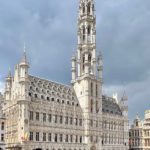As any honest student of the humanities should, I am passionate about history – the field through which we contextualize our present by studying our shared past. Of the many domains of historical study, the history of science is one of most rewarding to study. One develops both a reverence for the field and a respect for the fact that its practitioners are human, just as we are and by consequence, subject to the same failings.
Of particular interest to me are those developments in the field that relied on the heuristic of Beauty – that is, the expectation that a functional theory or solution will be beautiful in nature. One’s immediate counter is to point to the inherent subjectivity of this idea; you’d have to be more specific in your description of beauty. Indeed, each of the lauded examples of beautiful or elegant theories or solutions e.g., Einstein’s General Relativity, Planck’s laws, or Dirac’s equations, are each pleasing in their own ways. Admittedly, these examples are anecdotes – they are notable in large measure because they are the exceptions.
Nonetheless, each anecdote reveals some important human affection for beauty, which one so often loses track of when studying scientific history.
One such anecdote features Dublin’s own Sir William Rowan Hamilton.
The precocious son of a solicitor, he received his earliest education under the tutorage of his uncle, James Hamilton, an Anglican priest who lived with the young Hamilton from the tender age of 3 until his admittance to college. He was educated by his uncle, James Hamilton, an Anglican priest with whom he lived from the tender age of three until he entered college. An early bloomer, Hamilton was, as from the age of 5, the scope of his education grew from an already impressive study of Greek, Latin and Hebrew to Arabic, Sanskrit, Persian, Syriac, French and Italian by 12 years of age.
His talents would fully blossom in his tenure as a distinguished Mathematician and Andrews Professor of Astronomy at Trinity College. Among his many intellectual contributions, Hamilton is perhaps best known for one such problem that so perpetually defied him that it would take a miracle to solve.
The problem in question was the pursuit of a number system analogous to the complex number plane but that worked in 3-dimensions.
The story goes that each morning at their breakfast table William’s young son Archibald would, without fail, pester him over his progress on this pet pursuit of his. Several years of his career were committed to solving this problem, but to no avail.
It wasn’t until the year 1843 on a bright October’s day, while crossing the beautiful Broom Bridge to a meeting at the Royal Irish Academy, that his belabored mind converged on a sudden breakthrough. As if emerging from thin air, a solution materialized itself in his head. In his excitement, he grabbed his penknife and carved into the stone, the following discovery:
i2 = j2=k2=ijk=-1
The Quaternions
What am I looking at here, you casually enquire? I’m not going to bore the reader with the details but let’s say the formula amounts to a revolutionary mathematical tool with applications in computer-generated graphics, computer vision, quantum mechanics, robotics, navigation, modelling molecular and mechanical dynamics such as the orbital mechanics of satellites and the dynamics of airborne flight.
Of course, we can’t glance over the brilliance of Hamilton in this story, for it was after all, the thousands of strenuous hours of work that bore the heat and burden of the day in preparation for this conceptual breakthrough. Had the scenery been different on that day, one is tempted to wonder, would he have made the same breakthrough? It may have been decades, if not centuries, delayed otherwise.
Today I visited the site in question, where his Eureka moment is immortalized by a plaque etched into stone. With the arresting beauty that surrounds this quant bridge, particularly on a sunnier day, it is not hard to imagine being confronted with blissful insight, or at least divergent perspective.
Despite all its contention, what little do we risk losing by betting on beauty?








